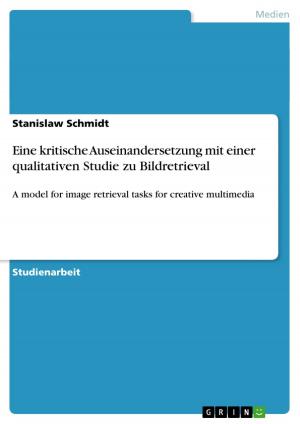Open Range - Negotiating a Traditional Western in the 21st Century
Nonfiction, Entertainment, Drama, Anthologies| Author: | Johannes Steinl | ISBN: | 9783640908189 |
| Publisher: | GRIN Verlag | Publication: | May 5, 2011 |
| Imprint: | GRIN Verlag | Language: | German |
| Author: | Johannes Steinl |
| ISBN: | 9783640908189 |
| Publisher: | GRIN Verlag |
| Publication: | May 5, 2011 |
| Imprint: | GRIN Verlag |
| Language: | German |
Studienarbeit aus dem Jahr 2010 im Fachbereich Amerikanistik - Literatur, , Sprache: Deutsch, Abstract: Cattle being driven through a lush, green valley, a cowboy sitting on his horse with his back to the audience looking out into the open range of America's Midwest, only limited by the horizon, dark clouds gathering on the far left side of the picture; these are the first images the viewer gets from Kevin Costner's 2003 Western movie, Open Range . And, in fact, this is all the audience needs, to know what this movie is going to be about. Open Range is made in the tradition of a classic Western. The cinematography of the opening sequence already establishes that. During these long shots the camera literally dwells in the scenery, showing America's open range, at its best - one could add. The symbolic meaning is conveyed immediately, since the audience recognizes the movie's frontier setting. Since the Western genre has undergone a freefall since the late 1970s not only in public interest, which is shown in box office rates, but also in its critical reception, it is interesting, that director Costner refers back to the Western's grand age in Open Range, even more so if one considers the public, as well as, the critical success of the two most prominent Westerns of the 1990s. Both Clint Eastwood's Unforgiven and Dances With Wolves also by and with Kevin Costner offered a new interpretation of the classic Western, to be honored with an Oscar for best picture in the process. So why does Costner then in Open Range take on the classic model of the Western again? The purpose of this paper is to try to give an answer to this question. To do so it is first necessary to investigate in how far Open Range can be considered a classic Western movie and how deviations can be interpreted. Having done so, we will have to read our findings against the political and cultural context of the time of production of Open Range, since movies are cultural products and especially in the case of the Western trigger certain expectations, which in our case address the central idea of American self-understanding, the frontier myth. The story told in the Western hence becomes a 'cultural story' .
Studienarbeit aus dem Jahr 2010 im Fachbereich Amerikanistik - Literatur, , Sprache: Deutsch, Abstract: Cattle being driven through a lush, green valley, a cowboy sitting on his horse with his back to the audience looking out into the open range of America's Midwest, only limited by the horizon, dark clouds gathering on the far left side of the picture; these are the first images the viewer gets from Kevin Costner's 2003 Western movie, Open Range . And, in fact, this is all the audience needs, to know what this movie is going to be about. Open Range is made in the tradition of a classic Western. The cinematography of the opening sequence already establishes that. During these long shots the camera literally dwells in the scenery, showing America's open range, at its best - one could add. The symbolic meaning is conveyed immediately, since the audience recognizes the movie's frontier setting. Since the Western genre has undergone a freefall since the late 1970s not only in public interest, which is shown in box office rates, but also in its critical reception, it is interesting, that director Costner refers back to the Western's grand age in Open Range, even more so if one considers the public, as well as, the critical success of the two most prominent Westerns of the 1990s. Both Clint Eastwood's Unforgiven and Dances With Wolves also by and with Kevin Costner offered a new interpretation of the classic Western, to be honored with an Oscar for best picture in the process. So why does Costner then in Open Range take on the classic model of the Western again? The purpose of this paper is to try to give an answer to this question. To do so it is first necessary to investigate in how far Open Range can be considered a classic Western movie and how deviations can be interpreted. Having done so, we will have to read our findings against the political and cultural context of the time of production of Open Range, since movies are cultural products and especially in the case of the Western trigger certain expectations, which in our case address the central idea of American self-understanding, the frontier myth. The story told in the Western hence becomes a 'cultural story' .















